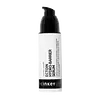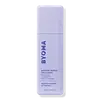What's inside
What's inside
 Key Ingredients
Key Ingredients

 Benefits
Benefits

 Concerns
Concerns

 Ingredients Side-by-side
Ingredients Side-by-side

Water
Skin ConditioningPropanediol
SolventCaprylic/Capric Triglyceride
MaskingCoconut Alkanes
EmollientEctoin 2%
Skin ConditioningHydrolyzed Sodium Hyaluronate
Skin ConditioningSodium Hyaluronate
HumectantMaltodextrin
AbsorbentPhenoxyethanol
PreservativeSodium Stearoyl Glutamate
CleansingPanthenol
Skin ConditioningCetearyl Alcohol
EmollientSclerotium Gum
Emulsion StabilisingXanthan Gum
EmulsifyingGlyceryl Stearate
EmollientJojoba Esters
EmollientCoco-Caprylate/Caprate
EmollientEthylhexylglycerin
Skin ConditioningSodium Citrate
BufferingHelianthus Annuus Seed Wax
Skin ConditioningCitric Acid
BufferingPolyglyceryl-10 Stearate
Skin ConditioningAvena Sativa Kernel Extract
AbrasiveGlycerin
HumectantLeuconostoc/Radish Root Ferment Filtrate
AntimicrobialTriethyl Citrate
MaskingPentylene Glycol
Skin ConditioningPolyglyceryl-6 Behenate
Emulsion StabilisingSodium Hyaluronate Crosspolymer
HumectantCeramide NP
Skin ConditioningHyaluronic Acid
HumectantCeramide AP
Skin ConditioningCholesterol
EmollientPhytosphingosine
Skin ConditioningBehenic Acid
CleansingSodium Levulinate
Skin ConditioningPolyglycerin-3
HumectantPotassium Sorbate
PreservativeSodium Cetearyl Sulfate
CleansingCeramide EOP
Skin ConditioningWater, Propanediol, Caprylic/Capric Triglyceride, Coconut Alkanes, Ectoin 2%, Hydrolyzed Sodium Hyaluronate, Sodium Hyaluronate, Maltodextrin, Phenoxyethanol, Sodium Stearoyl Glutamate, Panthenol, Cetearyl Alcohol, Sclerotium Gum, Xanthan Gum, Glyceryl Stearate, Jojoba Esters, Coco-Caprylate/Caprate, Ethylhexylglycerin, Sodium Citrate, Helianthus Annuus Seed Wax, Citric Acid, Polyglyceryl-10 Stearate, Avena Sativa Kernel Extract, Glycerin, Leuconostoc/Radish Root Ferment Filtrate, Triethyl Citrate, Pentylene Glycol, Polyglyceryl-6 Behenate, Sodium Hyaluronate Crosspolymer, Ceramide NP, Hyaluronic Acid, Ceramide AP, Cholesterol, Phytosphingosine, Behenic Acid, Sodium Levulinate, Polyglycerin-3, Potassium Sorbate, Sodium Cetearyl Sulfate, Ceramide EOP
Water
Skin ConditioningGlycerin
HumectantButylene Glycol
HumectantPentaerythrityl Tetraisostearate
EmollientButylene Glycol Dicaprylate/Dicaprate
EmollientDiisostearyl Malate
EmollientCetyl Ethylhexanoate
EmollientMethyl Trimethicone
Skin ConditioningButyrospermum Parkii Butter
Skin ConditioningPhenyl Trimethicone
Skin ConditioningBehenyl Alcohol
EmollientCetearyl Olivate
Cetearyl Alcohol
EmollientSqualane
EmollientPersea Gratissima Oil
Skin ConditioningSorbitan Olivate
EmulsifyingC14-22 Alcohols
Emulsion StabilisingEctoin
Skin ConditioningDipropylene Glycol
HumectantSimethicone
EmollientEthylhexylglycerin
Skin ConditioningSphingolipids
EmollientArachidyl Glucoside
Emulsifying1,2-Hexanediol
Skin ConditioningGlucose
HumectantCeramide NP
Skin ConditioningPolyacrylate-13
Hydroxyacetophenone
AntioxidantPalmitic Acid
EmollientArachidyl Alcohol
EmollientC11-13 Isoparaffin
SolventStearic Acid
CleansingC12-20 Alkyl Glucoside
EmulsifyingHydrogenated Polyisobutene
EmollientIsohexadecane
EmollientCaprylyl Glycol
EmollientDimethiconol
EmollientAllantoin
Skin ConditioningCarbomer
Emulsion StabilisingAmmonium Acryloyldimethyltaurate/Vp Copolymer
Tromethamine
BufferingSodium Hyaluronate
HumectantPolyglyceryl-10 Laurate
Skin ConditioningEthylhexyl Palmitate
EmollientSorbitan Isostearate
EmulsifyingSodium Phytate
Cyanocobalamin
Skin ConditioningDipotassium Glycyrrhizate
HumectantTocopherol
AntioxidantWater, Glycerin, Butylene Glycol, Pentaerythrityl Tetraisostearate, Butylene Glycol Dicaprylate/Dicaprate, Diisostearyl Malate, Cetyl Ethylhexanoate, Methyl Trimethicone, Butyrospermum Parkii Butter, Phenyl Trimethicone, Behenyl Alcohol, Cetearyl Olivate, Cetearyl Alcohol, Squalane, Persea Gratissima Oil, Sorbitan Olivate, C14-22 Alcohols, Ectoin, Dipropylene Glycol, Simethicone, Ethylhexylglycerin, Sphingolipids, Arachidyl Glucoside, 1,2-Hexanediol, Glucose, Ceramide NP, Polyacrylate-13, Hydroxyacetophenone, Palmitic Acid, Arachidyl Alcohol, C11-13 Isoparaffin, Stearic Acid, C12-20 Alkyl Glucoside, Hydrogenated Polyisobutene, Isohexadecane, Caprylyl Glycol, Dimethiconol, Allantoin, Carbomer, Ammonium Acryloyldimethyltaurate/Vp Copolymer, Tromethamine, Sodium Hyaluronate, Polyglyceryl-10 Laurate, Ethylhexyl Palmitate, Sorbitan Isostearate, Sodium Phytate, Cyanocobalamin, Dipotassium Glycyrrhizate, Tocopherol
 Reviews
Reviews

Ingredients Explained
These ingredients are found in both products.
Ingredients higher up in an ingredient list are typically present in a larger amount.
Ceramide NP is a type of ceramide and formally known as ceramide 3.
Ceramides are intercellular lipids naturally found in our skin that bonds dead skin cells together to create a barrier. They are known for their ability to hold water and thus are a great ingredient for dry skin.
Ceramides are an important building block for our skin barrier. A stronger barrier helps the skin look more firm and hydrated. By bolstering the skin ceramides act as a barrier against irritating ingredients. This can help with inflammation as well.
If you would like to eat ceramides, sweet potatoes contain a small amount.
Read more about other common types of ceramides here:
Ceramide AP
Ceramide EOP
Cetearyl alcohol is a mixture of two fatty alcohols: cetyl alcohol and stearyl alcohol. It is mainly used as an emulsifier. Emulsifiers help prevent the separation of oils and products. Due to its composition, it can also be used to thicken a product or help create foam.
Cetearyl alcohol is an emollient. Emollients help soothe and hydrate the skin by trapping moisture.
Studies show Cetearyl alcohol is non-toxic and non-irritating. The FDA allows products labeled "alcohol-free" to have fatty alcohols.
This ingredient is usually derived from plant oils such as palm, vegetable, or coconut oils. There is debate on whether this ingredient will cause acne.
Due to the fatty acid base, this ingredient may not be Malassezia folliculitis safe.
Learn more about Cetearyl AlcoholEctoin is a compound found naturally in some species of bacteria. It can be synthetically created for skincare use.
This ingredient is an osmolyte; Osmolytes help organisms survive osmotic shock (it protects them from extreme conditions). It does this by influencing the properties of biological fluids within cells.
When applied to the skin, ectoin helps bind water molecules to protect our skin. The water forms a sort of armor for the parts of our skin cells, enzymes, proteins, and more.
Besides this, ectoin has many uses in skincare:
A study from 2004 found ectoin to counteract the damage from UV-A exposure at different cell levels. It has also been shown to protect skin against both UV-A, UV-B rays, infrared light, and visible light.
Studies show ectoin to have dual-action pollution protection: first, it protects our skin from further pollution damage. Second, it helps repair damage from pollution.
In fact, ectoin has been shown to help with:
Fun fact: In the EU, ectoin is used in inhalation medication as an anti-pollution ingredient.
Ectoin is a highly stable ingredient. It has a wide pH range of 1-9. Light, oxygen, and temperature do not affect this ingredient.
Learn more about EctoinEthylhexylglycerin (we can't pronounce this either) is commonly used as a preservative and skin softener. It is derived from glyceryl.
You might see Ethylhexylglycerin often paired with other preservatives such as phenoxyethanol. Ethylhexylglycerin has been found to increase the effectiveness of these other preservatives.
Glycerin is already naturally found in your skin. It helps moisturize and protect your skin.
A study from 2016 found glycerin to be more effective as a humectant than AHAs and hyaluronic acid.
As a humectant, it helps the skin stay hydrated by pulling moisture to your skin. The low molecular weight of glycerin allows it to pull moisture into the deeper layers of your skin.
Hydrated skin improves your skin barrier; Your skin barrier helps protect against irritants and bacteria.
Glycerin has also been found to have antimicrobial and antiviral properties. Due to these properties, glycerin is often used in wound and burn treatments.
In cosmetics, glycerin is usually derived from plants such as soybean or palm. However, it can also be sourced from animals, such as tallow or animal fat.
This ingredient is organic, colorless, odorless, and non-toxic.
Glycerin is the name for this ingredient in American English. British English uses Glycerol/Glycerine.
Learn more about GlycerinSodium Hyaluronate is hyaluronic acid's salt form. It is commonly derived from the sodium salt of hyaluronic acid.
Like hyaluronic acid, it is great at holding water and acts as a humectant. This makes it a great skin hydrating ingredient.
Sodium Hyaluronate is naturally occurring in our bodies and is mostly found in eye fluid and joints.
These are some other common types of Hyaluronic Acid:
Learn more about Sodium HyaluronateWater. It's the most common cosmetic ingredient of all. You'll usually see it at the top of ingredient lists, meaning that it makes up the largest part of the product.
So why is it so popular? Water most often acts as a solvent - this means that it helps dissolve other ingredients into the formulation.
You'll also recognize water as that liquid we all need to stay alive. If you see this, drink a glass of water. Stay hydrated!
Learn more about Water